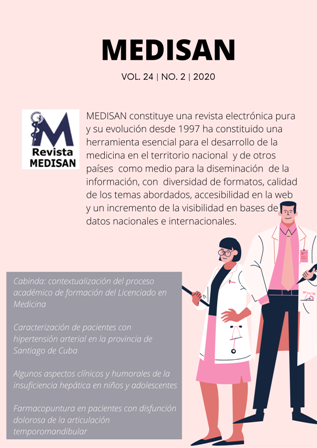Clinical, epidemiological and microbiological characterization of patients with sepsis in an intensive cares unit
Keywords:
sepsis, Escherichia coli, Intensive Cares Unit, infection.Abstract
Introduction: The incidence, morbidity and mortality of sepsis transforms it into an important health care problem that requires the adoption of specific measures, in order to take conscience of the problem.
Objectives: To characterize the patients with sepsis according to selected clinical, epidemiological and microbiological variables.
Methods: A descriptive and cross-sectional study of 119 patients with sepsis, discharged from the Intensive Cares Unit of Orlando Pantoja Tamayo General Hospital, in Contramaestre was carried out, from January, 2014 to July, 2017. The chi-square test was applied, to identify association statistically significant between the variables, with a significance level of α = 0.05.
Results: There was a prevalence of females (54.6 %), 66-80 years age group for both sexes (33.6 %) and pneumonia associated to ventilation as the most frequent form of presentation of sepsis (51.6 %), mainly the one produced by Enterobacter sp. (34.4 %).
Conclusions: Sepsis is presented fundamentally by breathing infections produced by gramnegative germs in patients who required invasive procedures as part of the treatment.
Downloads
References
2. Pertuz Meza Y, Perez Quintero C, Pabón Varela Y. Aspectos epidemiológicos de la sepsis, en unidades de cuidados intensivos Santa Marta, Colombia. Duazary. 2016 [citado 23/06/2019];13(2). Disponible en: http://revistas.unimagdalena.edu.co/index.php/duazary/article/view/1718
3. Carvajal Estupiñán JF, Naranjo Junoy F, Ospina Díaz JM. Caracterización de pacientes diagnosticados con sepsis en una unidad de cuidados intensivos de Bucaramanga, Colombia 2010-2011: estudio descriptivo. Rev. Arch de Med. 2016. [citado 23/06/2019];16(1):53-60. Disponible en: http://revistasum.umanizales.edu.co/ojs/index.php/archivosmedicina/article/view/1538/1777
4. Poutsiaka DD, Davidson LE, Kahn KL, Bates DW, Snydman DR, Hibberd PL. Risk factors for death after sepsis in patients immunosuppressed before the onset of sepsis. Scand J Infect Dis. 2009 [citado 23/06/2019];41:469-79. Disponible en: https://www.ncbi.nlm.nih.gov/pmc/articles/PMC4129637/
5. Cantín M. Declaración de Helsinki de la Asociación Médica Mundial: principios éticos para las investigaciones médicas en seres humanos. Int J Med Surg Sci. 2014; 1(4):339-46.
6. Arce Coronado IA, Ayala Gutiérrez A. Fisiología del envejecimiento. Rev Med Act Clin. 2012 [citado 23/06/2019];17:813-18. Disponible en: https://docplayer.es/75653341-Revista-de-actualizacion-clinica-volumen.html
7. Azkárate I, Choperena G, Salas E, Sebastián R, Lara G, Elósegui I, et al. Epidemiología y factores pronósticos de la sepsis grave/shock séptico. Seis años de evolución. Rev Med Inten. 2016 [citado 23/06/2019]; 40(1):18-25. Disponible en: https://www.medintensiva.org/es-epidemiologia-factores-pronosticos-sepsis-grave-shock-articulo-S0210569115000248
8. Pérez Benítez MR, Sánchez L. Actualización de la sepsis en adultos. Código sepsis. Andalucía: Universidad Internacional; 2015 [citado 10/05/2019]. Disponible en: https://dspace.unia.es/bitstream/handle/10334/3418/0607_P%c3%a9rez.pdf?sequence=3&isAllowed=y
9. Pérez Moreno MA, Calderón Hernanz B, Comas Díaz B, Tarradas Torras J, Borges Sa M. Análisis de la concordancia del tratamiento antibiótico de pacientes con sepsis grave en urgencias. Rev Esp Quimioter. 2015 [citado 23/06/2019];28(6):295-301. Disponible en: https://seq.es/wp-content/uploads/2015/02/seq_0214-3429_28_6_perez.pdf
10. Gómez Gómez B, Sánchez Lun JP, Pérez Beltrán CF, Díaz Greene EJ, Rodríguez Weber FL. Choque séptico. Lo que sabíamos y lo que debemos saber. Med Int Méx. 2017 [citado 23/06/2019];33(3):381-91. Disponible en: http://www.scielo.org.mx/scielo.php?script=sci_arttext&pid=S0186-48662017000300381
11. Hernández Oliva M, Merlán Pérez AI, Álvarez González R. Factores pronósticos de pacientes con sepsis en cuidados intensivos. Rev Cubana Med Inten Emerg. 2018 [citado 23/05/2019];17(1):35-46. Disponible en: http://www.medigraphic.com/pdfs/revcubmedinteme/cie-2018/cie181d.pdf
12. Pujol M, Limón E. Epidemiología general de las infecciones nosocomiales. Sistemas y programas de vigilancia. Enferm Infecc Microbiol Clin. 2013 [citado 23/05/2019];31(2):108–13.Disponible en: https://www.elsevier.es/es-revista-enfermedades-infecciosas-microbiologia-clinica-28-articulo-epidemiologia-general-las-infecciones-nosocomiales--S0213005X13000025
13. Cardoso T, Ribeiro O, Aragão IC, Costa Pereira A, Sarmento AE. Additional risk factors for infection by multidrug-resistant pathogens in healthcare-associated infection: A large cohort study. BMC Infect Dis. 2012 [citado 23/05/2019];12:375. Disponible en: https://www.ncbi.nlm.nih.gov/pubmed/23267668
Published
How to Cite
Issue
Section
License
All the articles can be downloaded or read for free. The journal does not charge any amount of money to the authors for the reception, edition or the publication of the articles, making the whole process completely free. Medisan has no embargo period and it is published under the license of Creative Commons, International Non Commercial Recognition 4.0, which authorizes the copy, reproduction and the total or partial distribution of the articles in any format or platform, with the conditions of citing the source of information and not to be used for profitable purposes.





